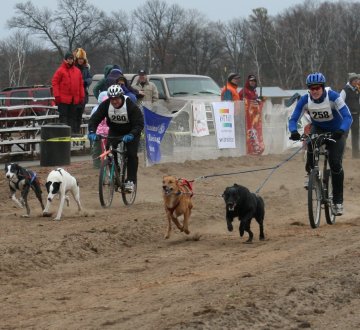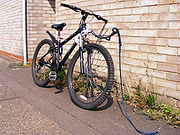
Bikejoring
Encyclopedia

Mushing
Mushing is a general term for a sport or transport method powered by dogs, and includes carting, pulka, scootering, sled dog racing, skijoring, freighting, and weight pulling. More specifically, it implies the use of one or more dogs to pull a sled on snow or a rig on dry land...
activity related to skijoring
Skijoring
Skijoring is a winter sport where a person on skis is pulled by a horse, a dog or a motor vehicle. It is derived from the Norwegian word skikjøring meaning ski driving.- Dog skijoring :...
, canicross
Canicross
Cani-cross is the sport of cross-country running while hitched to a dog. It is popular in Europe. It is related to the winter dog-powered sport of skijoring and bikejoring, wherein a skier or cyclist is hitched to one to three dogs....
, and dog scootering
Dog scootering
Dog scootering is a sport where one or more dogs pull a human riding an unmotorized kick scooter. It is similar to mushing, which is done in the winter, but generally with fewer dogs and with a scooter instead of a dogsled. The dogs wear the same harnesses that sled dogs wear, and are hooked to...
. It is a recreation or sport where a harnessed dog or team of dog
Dog
The domestic dog is a domesticated form of the gray wolf, a member of the Canidae family of the order Carnivora. The term is used for both feral and pet varieties. The dog may have been the first animal to be domesticated, and has been the most widely kept working, hunting, and companion animal in...
s attached to a towline, pull and run ahead of a cyclist. Bikejoring is a non snow season (dryland) activity. Bikejoring and canicross
Canicross
Cani-cross is the sport of cross-country running while hitched to a dog. It is popular in Europe. It is related to the winter dog-powered sport of skijoring and bikejoring, wherein a skier or cyclist is hitched to one to three dogs....
are both dryland mushing activities that probably developed from skijoring
Skijoring
Skijoring is a winter sport where a person on skis is pulled by a horse, a dog or a motor vehicle. It is derived from the Norwegian word skikjøring meaning ski driving.- Dog skijoring :...
and dogsled racing
Dogsled racing
Sled dog racing is a winter dog sport most popular in the Arctic regions of the United States, Canada, Russia, and some European countries. It involves the timed competition of teams of sleddogs that pull a sled with the dog driver or musher standing on the runners...
. Bikejoring is also sometimes used to train racing sled-dogs out of season.
Although any breed (or non-breed) of dog can be used, American Pit Bulls, Siberian Huskies, Samoyeds, Malamutes, Alaskan Huskies, Sled Hounds and Pointers are probably the most popular breeds for bikejoring. However, any type of dog that can be taught to pull, run, and to accept a few lead dog commands can be used to bikejor. Bikejoring and dog scootering
Dog scootering
Dog scootering is a sport where one or more dogs pull a human riding an unmotorized kick scooter. It is similar to mushing, which is done in the winter, but generally with fewer dogs and with a scooter instead of a dogsled. The dogs wear the same harnesses that sled dogs wear, and are hooked to...
are activities that can be beneficial to the health and fitness of dogs. It can be used to provide dogs with work and exercise, without letting them run off leash and endangering wild-life or livestock.
Although often practiced as a dog exercising recreation, in some parts of the World, dog sporting organizations and mushers (people who train dogs to pull - mushing
Mushing
Mushing is a general term for a sport or transport method powered by dogs, and includes carting, pulka, scootering, sled dog racing, skijoring, freighting, and weight pulling. More specifically, it implies the use of one or more dogs to pull a sled on snow or a rig on dry land...
) provide bikejor and dog-scooter racing classes at their competitive dryland sled-dog rallies and events. These competitive bikejor classes often run alongside other classes for canicross and dryland rig racing. In most cases, the competitors are started off separately on a timer, to avoid tangles and collisions.
The dog or dogs are fitted with harnesses suitable for pulling and running in, such as x-back harnesses. The harnesses are normally attached to a gang line (if more than one dog is being used), and a bungee towline, which clips to the front of the bicycle. Many bikejorers use bayonets, antennas, or plastic pipes to suspend the towline above the front wheel, and to prevent it from tangling between the wheel and forks. If two dogs are employed on a gang line, they are sometimes also attached to each other by a neckline between their collars. Bikejoring can be fun but has its dangers. The dogs may be distracted by wild-life.

Scooters are often used instead of bicycles, as they are easier to dismount if the dogs decide to give chase to an animal. Although exactly the same as bikejoring except that a scooter is used to carry the musher instead of a bicycle, this activity is known as dog scootering
Dog scootering
Dog scootering is a sport where one or more dogs pull a human riding an unmotorized kick scooter. It is similar to mushing, which is done in the winter, but generally with fewer dogs and with a scooter instead of a dogsled. The dogs wear the same harnesses that sled dogs wear, and are hooked to...
rather than as bikejoring. The musher can still assist the dog/s by kicking at the trail, rather than by pedalling. The scooters used are usually rugged enough for carrying an adult cross country. Some scooters are manufactured specifically for dog-scootering.
An easier and maybe safer alternative to bikejoring or dog-scootering , especially for use in urban and built up areas, is to attach a dog to the side of a bicycle using a number of designed dog-bicycle attachments. However, these patented side attachments are designed to allow a dog to run beside a bicycle, rather than to pull it from ahead. These patented dog-bike attachments usually include some sort of shock absorption, usually a spring. Some of these side attachments can be fitted either side of a bicycle so that two dogs can be exercised at the same time. Examples of these dog-bicycle attachments are the WalkyDog, Springer, bikejor converter and more recently the bikejoring attachment.


